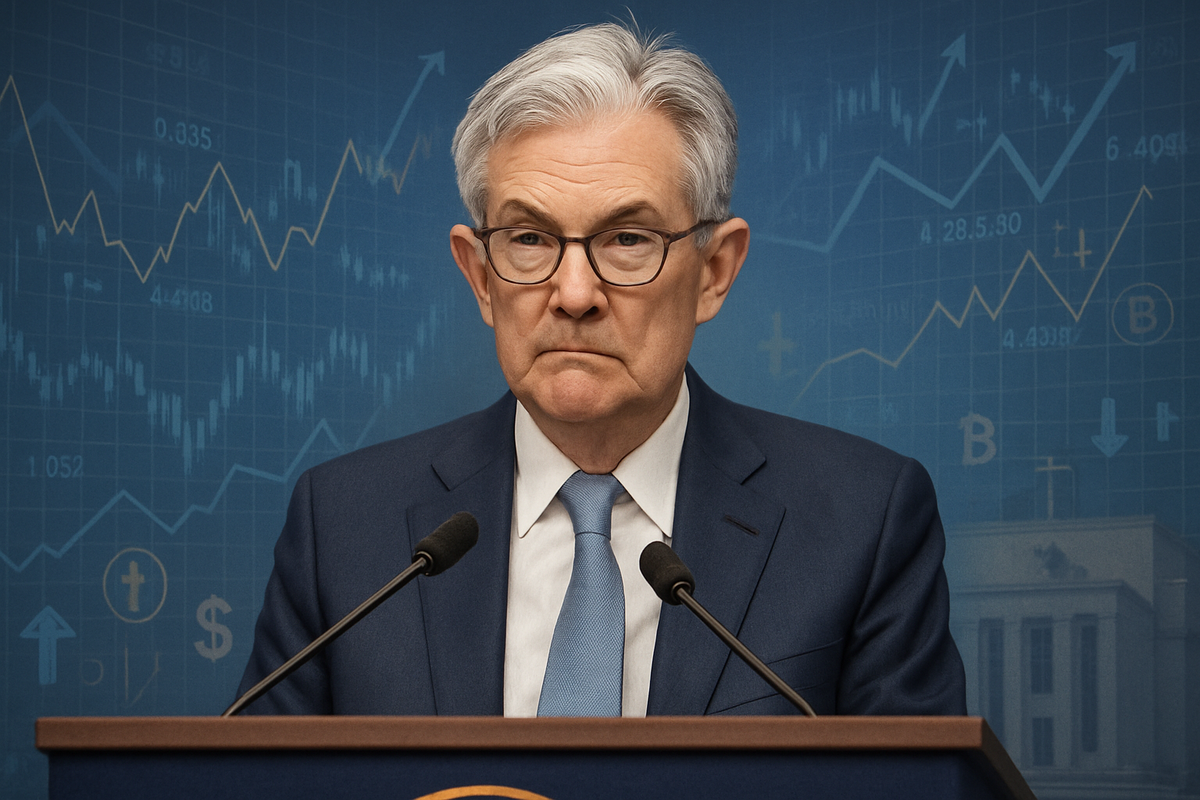
As the U.S. economy navigates a complex period of moderating growth, persistent inflation, and a softening labor market, all eyes are fixed on Federal Reserve Chair Jerome Powell. His highly anticipated speech on Tuesday, October 14, 2025, at the National Association for Business Economics (NABE) Annual Meeting in Philadelphia, Pennsylvania, is set to be a defining moment for financial markets. Investors, businesses, and policymakers alike are keenly awaiting his insights into the nation's economic outlook and the future trajectory of monetary policy, particularly following a recent U.S. government shutdown that has delayed crucial economic data.
The anticipation surrounding Powell's remarks is palpable, especially after the Fed's September rate cut, which brought the federal funds rate to a range of 4.00%-4.25%. Markets are currently pricing in a high probability of another interest rate cut in October and an even further reduction in December 2025. The recently released Federal Open Market Committee (FOMC) minutes from September underscored a "dovish outlook," suggesting that most officials foresee federal funds rate declines in the near future. This context makes Powell's upcoming address even more critical, as it is expected to offer much-needed guidance in an environment of economic uncertainty and data scarcity.
Unpacking Powell's Agenda: A Glimpse into the Fed's Strategy
Jerome Powell's speech, scheduled for 12:20 p.m. ET, comes at a critical juncture, with the Fed grappling with a delicate balancing act. The central bank's actions are aimed at managing the "two-sided risks" of an economy that is simultaneously experiencing elevated inflation and a weakening labor market.
Powell is expected to elaborate on several key areas that will shape the Fed's policy decisions:
- U.S. Economic Outlook: An updated assessment of the economy's health is paramount. Powell's previous observations have pointed to a moderating pace of economic growth, a struggling housing sector, and slowing job gains. His latest commentary will provide clarity on whether these trends are accelerating or stabilizing.
- Monetary Policy Stance: The primary focus will undoubtedly be on the future of interest rates. Following the September rate cut, markets will be scrutinizing every word for indications on the pace and magnitude of potential further cuts in the latter half of 2025. Will the Fed signal a pause, a continued easing, or a more aggressive approach?
- Inflation Dynamics: Despite the economic slowdown, inflation "remains somewhat elevated relative to our 2% longer-run goal." Powell will likely address the persistence of inflationary pressures, including the impact of imported inflation related to tariffs, and how the Fed plans to manage the risk of sustained price increases. The Fed's more flexible approach to its 2% inflation target suggests a data-dependent strategy rather than a rush to cut rates without supportive economic data.
- Labor Market Conditions: With job gains slowing and downside risks to employment rising (unemployment reached 4.3% in August 2025), Powell is expected to comment on the health of the labor market. The ongoing dilemma between tackling elevated inflation and avoiding rising unemployment, which has caused divisions among Fed officials, may also be addressed.
- Impact of Data Delays: The ongoing government shutdown in October 2025 has delayed crucial economic data releases. Powell may touch upon how this lack of up-to-date information is influencing the Fed's decision-making process and the challenges it poses for policy formulation.
Historically, Fed chairs' speeches frequently trigger significant market movements, and this upcoming address is expected to be no different. Any clear signals regarding the Federal Reserve's commitment to further rate cuts will likely be met with positive sentiment in equity markets, as lower rates tend to make capital cheaper and encourage investment in riskier assets. Conversely, a more "hawkish" (tighter monetary policy) tone than anticipated could lead to profit-taking and short-term market corrections. The U.S. dollar's value against other major currencies and bond yields will also react swiftly to clarity on the Fed's rate path.
The cryptocurrency market is particularly sensitive to the Federal Reserve's monetary policy and overall liquidity conditions. Historically, interest rate cuts tend to favor cryptocurrency performance by reducing the opportunity cost of holding traditional investments. If Powell confirms a gradual monetary easing path, a positive market sentiment could emerge, potentially driving capital flows into Bitcoin ETFs and making cryptocurrencies more attractive. Bitcoin often acts as a "safe asset" during periods of uncertainty, and its position could strengthen depending on Powell's outlook. Additionally, sustained inflation above target levels could bolster Bitcoin's narrative as a "hard asset." Should macroeconomic stability be emphasized, investor interest may extend to altcoins, with some already showing strong short-term gains, hinting at a potential "altseason."
Companies on the Cusp: Winners and Losers in a Shifting Rate Environment
The Federal Reserve's pivot towards potential interest rate cuts is poised to create a distinct landscape of winners and losers across various sectors of the public market. The aim of stimulating economic activity by making borrowing cheaper for consumers and businesses can lead to increased corporate profits and economic growth.
Potential Winners:
- Homebuilding and Construction: This sector is exceptionally sensitive to interest rates. Lower mortgage rates make home loans more affordable, directly stimulating housing demand and property sales. Companies like Lennar Corporation (NYSE: LEN), D.R. Horton (NYSE: DHI), Builders FirstSource (NASDAQ: BLDR), and Mohawk Industries (NYSE: MHK) could see increased activity and improved financial performance.
- Technology: While initial reactions to rate cuts can be mixed, the technology sector often rebounds over a 12-month period. Lower interest rates reduce borrowing costs, which is particularly beneficial for growth-oriented technology companies that rely on debt financing for expansion and research and development. Firms focused on AI integration, for instance, could see increased R&D spending and M&A activity.
- Consumer Discretionary: Cheaper borrowing costs can encourage consumers to take on more debt for significant purchases and generally increase disposable income. This can boost sectors such as retail, travel, and leisure.
- Industrials: Capital-intensive industrial projects often benefit from lower borrowing costs. Companies in this sector, such as construction equipment maker Caterpillar (NYSE: CAT), could see increased demand and activity.
- Highly Leveraged Companies & Small-Cap Stocks: Businesses carrying substantial debt burdens will experience a reduction in their interest expenses, leading to improved profitability and cash flow. Small-cap stocks, often more sensitive to rate changes, are generally expected to receive a boost.
Potential Losers (or those facing headwinds):
- Financial Institutions (Banks): While lower rates can stimulate overall market activity, they typically compress net interest margins (NIMs)—the difference between what banks earn on loans and what they pay on deposits. This can reduce profitability for traditional banks like JPMorgan Chase (NYSE: JPM) and Bank of America (NYSE: BAC).
- Insurance Companies: Insurers, especially those with long-duration liabilities or who invest heavily in fixed-income securities, may see their liabilities increase in present value or experience reduced returns on their investments due to lower yields, impacting overall profitability.
- Companies with Strong Cash Positions: Businesses holding large amounts of cash or short-term investments may experience reduced interest income on these holdings, slightly impacting their overall financial performance.
- Utilities and Real Estate Investment Trusts (REITs): The impact here is nuanced. While lower borrowing costs can benefit utilities if they are highly leveraged, their appeal as defensive income plays might diminish if bond yields become less competitive, causing investors to seek higher returns elsewhere. Similarly, REITs might become less attractive if lower interest rates lead to comparatively less appealing yields.
Investors will need to closely monitor the actual pace and magnitude of future rate cuts, inflation and unemployment trajectories, and corporate earnings reports, particularly from these interest-rate-sensitive sectors.
Wider Significance: A Global Ripple Effect
Jerome Powell's speech and the Federal Reserve's monetary policy shifts in 2025 are deeply embedded in broader economic trends, creating significant ripple effects across global markets and carrying substantial regulatory and historical implications. The Fed's pivot towards an accommodative stance, marked by recent interest rate cuts, is a strategic move to navigate a complex economic landscape characterized by a slowing U.S. labor market, persistent inflation, and divergent global economic conditions.
The Fed's actions are taking place amidst several key trends: the U.S. labor market has shown signs of deceleration, with weak job gains and an unemployment rate rising to 4.3% in August 2025. Despite this, core Personal Consumption Expenditures (PCE) inflation remained elevated at 2.9% in August 2025, consistently above the Fed's 2% target. This creates a delicate balancing act to support growth without reigniting inflation. Globally, there's an economic divergence, with resilient growth in some areas and contractions in others, all influencing the Fed's policy calculations. The ongoing U.S. government shutdown further complicates the picture by delaying crucial economic data, forcing the Fed to rely more on private-sector information.
The ripple effects are far-reaching:
- Global Financial Markets: A dovish pivot by the Fed typically ignites a "risk-on" sentiment in global equity markets, potentially pushing major indices to new highs. However, underlying anxieties about economic jitters, potential asset bubbles, and political uncertainties could temper this optimism.
- Equities and Bonds: Expectations of lower borrowing costs can boost corporate profits, making equities more attractive. Bond markets have reacted decisively, with U.S. Treasury yields and the U.S. dollar falling due to expectations of lower interest rates. The yield curve is beginning to normalize.
- Commodities: Commodity markets show varied responses. Oil prices have seen gains, while gold has demonstrated strong performance as lower rates reduce the opportunity cost of holding non-yielding assets and increase its appeal as a safe-haven asset.
- Emerging Markets: As investors chase higher yields, emerging markets often attract capital inflows during periods of Fed easing.
- Currency Markets: The U.S. dollar has declined modestly. A weaker dollar can limit the extent of monetary easing in other regions, especially in emerging markets, due to currency depreciation and capital outflows.
- Other Central Banks: Many foreign central banks, including the European Central Bank (ECB), Reserve Bank of New Zealand, and Reserve Bank of Australia, are either holding policy rates steady or resuming rate reductions, influenced by global disinflation and U.S. policy.
Regulatory and policy implications also arise. The Fed's dual mandate—to maintain maximum employment and stable prices—can lead to conflicts, prompting debates about whether its multiple roles should be separated. Furthermore, there are growing tensions between expansionary fiscal policies and the central banks' easing stance, which could complicate efforts to manage inflation and ensure long-term debt sustainability.
Historically, the Fed has a long track record of adapting its monetary policy to significant economic events, from the Great Depression to the 2008 financial crisis. The current easing cycle, characterized as "risk management" or "insurance cuts" to stave off an economic slowdown, mirrors historical instances where the Fed cut rates after a prolonged pause. In such "late-cycle, non-recessionary easing scenarios," asset classes like gold and U.S. high-yield bonds have historically delivered positive returns, while the U.S. Dollar Index has seen declines. These precedents provide a valuable lens through which to understand the potential outcomes and challenges of the Fed's current strategic adjustments.
What Comes Next: Navigating the Path Forward
Jerome Powell's upcoming speech and the Federal Reserve's strategic shift towards an easing cycle introduce a complex interplay of short-term and long-term possibilities, necessitating strategic pivots for businesses and investors. The overarching goal is to achieve a "soft landing"—a gradual moderation of inflation without triggering a deep recession.
Short-Term Possibilities (Q4 2025 and early 2026): The market is expected to maintain a "risk-on" sentiment, fueled by the anticipation of additional rate cuts. This could continue the bullish momentum in major U.S. stock indices, with capital flowing into equities and other higher-yielding assets. Lower borrowing costs will stimulate demand and investment, boosting areas like the mortgage market. However, inflation, particularly in services and housing, remains "somewhat elevated," creating a challenging situation where near-term inflation risks are tilted to the upside, and employment risks to the downside.
Long-Term Possibilities (Beyond 2026): The long-term outlook hinges on the Fed's ability to achieve a soft landing. While monetary policy can have long-run effects on an economy's productive capacity, sustained tight policy has been shown to reduce potential output. The Fed aims to bring inflation sustainably back to its 2% goal, maintaining credibility, as history shows that fighting persistent inflation can be costly. Structural economic changes, including trade and immigration policies, will also influence the long-term outlook.
Strategic Pivots and Adaptations:
- For Businesses: Lower rates incentivize businesses to take out loans for expansion, hiring, and new initiatives. Companies with existing floating-rate debt will see reduced interest expenses. However, careful pricing strategies are needed to manage input costs amidst elevated inflation and tariffs. Businesses should also focus on building resilient supply chains given ongoing geopolitical and trade disruptions.
- For Investors: Investors may shift towards equities and other growth-oriented assets, with technology and communication services sectors potentially thriving. Fixed income investors might find existing bonds with higher yields more attractive as rates fall, but returns on new bonds may decrease. Diversification within fixed income and international diversification, especially in emerging markets, could offer opportunities. Risk management remains crucial due to persistent inflation risks or a sharper labor market deterioration.
Market Opportunities and Challenges:
- Opportunities: Continued bullish momentum in U.S. equities (especially growth stocks and AI-related themes), strength in precious and industrial metals, attractive income potential in high-yield and emerging market bonds, and a resurgence in residential real estate.
- Challenges: The primary challenge is the risk of inflation remaining sticky or reigniting, which could force the Fed to reassess its easing strategy. A sharper decline in hiring or a significant jump in unemployment could raise the odds of a recession. Local banks may face ongoing credit quality concerns, particularly in consumer loans and the commercial real estate sector. Policy uncertainty from geopolitical developments or government shutdowns could also lead to market volatility.
Potential Scenarios and Outcomes: The most desired outcome is a Soft Landing, where the economy grows moderately, inflation eases, and the labor market cools without significant unemployment. Other scenarios include More Aggressive Easing if the labor market weakens rapidly, potentially leading to a faster recovery but also reigniting inflation risks. A Prolonged Inflation / Stagflation scenario could occur if inflation remains stickier, forcing the Fed to keep policy tighter for longer amidst a weakening jobs market. Lastly, a Recessionary Environment could unfold if a substantial labor market weakening or external shocks lead to a deeper downturn, prompting aggressive stimulus measures.
A Comprehensive Wrap-Up: Navigating the Economic Crossroads
Jerome Powell's upcoming speech is poised to be a landmark event, offering critical insights into the Federal Reserve's strategy for navigating a complex economic landscape. The Fed has already initiated a pivot towards monetary easing, evidenced by the September rate cut, in response to a softening labor market and the aim to sustain economic growth. However, this easing comes with the persistent challenge of elevated inflation, creating a delicate balancing act that will define the market's trajectory in the coming months.
The key takeaway is that the Fed is actively adapting to evolving economic conditions, seeking to achieve a "soft landing" where inflation gradually moderates without triggering a severe recession. This forward-looking approach, while generally positive for risk assets like equities and cryptocurrencies, is not without its complexities. The immediate implications include potential volatility in traditional markets, with interest-rate-sensitive sectors experiencing significant shifts. Cryptocurrencies, known for their sensitivity to liquidity conditions, could see further rallies if a dovish stance is confirmed, but also face risks from unexpected hawkish signals.
Moving forward, investors should prepare for a landscape characterized by both opportunities and challenges. Sectors like homebuilding, technology, and consumer discretionary are likely to benefit from lower borrowing costs, while financial institutions may face pressure on their net interest margins. The wider significance extends globally, impacting international markets, currencies, and other central banks as they react to the Fed's policy shifts.
What investors should watch for in coming months:
- Clarity on Rate Path: Any specific guidance from Powell on the pace and magnitude of future rate cuts will be paramount.
- Inflation Data: Persistent inflation, especially from core PCE, will be a critical indicator. If inflation remains sticky, it could force the Fed to reassess its easing strategy.
- Labor Market Reports: Pay close attention to unemployment rates and job growth figures. A rapid deterioration in the labor market could signal a deeper economic downturn.
- Corporate Earnings: Monitor earnings reports from interest-rate-sensitive sectors to gauge the real-world impact of monetary policy shifts.
- Geopolitical Developments: Ongoing geopolitical tensions and trade disruptions can introduce unexpected volatility and influence the Fed's decision-making.
The path ahead remains uncertain, but Powell's address will undoubtedly provide a clearer roadmap. Strategic adaptation, informed decision-making, and careful risk management will be essential for businesses and investors navigating these economic crossroads.
This content is intended for informational purposes only and is not financial advice


















